I've always been fascinated by the luxurious feel and rich history of velvet. Traditionally, 100% velvet is crafted from silk, which gives it that classic, sumptuous texture we all love. But there's more to velvet than just silk; other materials like cotton, synthetic fibers, and even wool play a part in its modern variations. Each type brings its own unique qualities to the table, influencing everything from texture to how it drapes. Let's explore what makes each kind of velvet special and why choosing the right type can make a huge difference in both fashion and home decor. Are you curious about which type might be best for your needs?
Table of Contents
Key Takeaways
- 100% velvet is typically made from pure silk, providing its luxurious texture and sheen.
- Silk velvet is known for its softness and high-quality feel.
- The fabric's plushness is enhanced by silk fibers doubled during weaving.
- Pure silk velvet often involves specialized dyeing techniques for vibrant color.
- It is considered the most premium form of velvet due to its composition and properties.
History of Velvet Fabric
Velvet has often graced the wardrobes of royalty and the wealthy throughout its rich history. Its allure began to skyrocket during the medieval era, marking its status as a luxury fabric. Initially produced in the East, velvet gained massive popularity in Europe, especially as the tastes of the medieval aristocracy grew more sophisticated. The fabric's deep, soft pile and shimmering surface made it a coveted material for clothing and furnishings alike.
The Renaissance period further amplified velvet's prominence, largely due to flourishing trade. As European merchants ventured more into Asia and the Middle East, they brought back not just spices and silks but also the techniques and materials to produce velvet. This period saw a significant evolution in textile technology and artistry, with Italian cities like Genoa, Florence, and Venice becoming centers of velvet production. These cities innovated and mastered the art of velvet weaving, blending silk with other fibers to create variations that appealed to the elite classes across Europe.
Understanding this historical context not only enriches one's appreciation of velvet but also underscores its enduring legacy as a symbol of luxury and sophistication in fabric history.
Traditional Silk Velvet Explained
Now, let's talk about traditional silk velvet, which is quite the luxurious fabric.
It's made using special techniques that weave together silk fibers to create its unique, plush texture.
Next, I'll explain both what it's made of and how it's produced, so you can truly appreciate its quality and craftsmanship.
Silk Velvet Composition
Traditional silk velvet is primarily composed of 100% pure silk, giving it a uniquely luxurious feel and appearance. Silk sources play a pivotal role in the quality of the velvet produced. The silk often comes from reputable farms that guarantee the fibers are of high quality, contributing to the fabric's overall softness and durability. Different weave patterns also impact the texture and drape of the velvet. For example, a tighter weave enhances the fabric's plushness and sheen, making it ideal for high-end fashion and upholstery.
Understanding these elements helps in appreciating why silk velvet stands out in the luxury fabric market. It's not just about the silk itself, but how it's sourced and woven into something truly exceptional.
Production Techniques
Let's explore how traditional silk velvet is made, focusing on the specific techniques that contribute to its exceptional quality. At the heart of its production are refined velvet weaving methods, which begin with selecting the finest silk fibers. These fibers are intricately woven on a special loom that creates the velvet's signature plush texture. The threads are doubled, involving a critical process where two layers of fabric are woven simultaneously, then cut apart to form the soft pile.
Next, dyeing techniques play a pivotal role in achieving vibrant colors that set high-quality velvet apart. The fabric is dyed using methods that ensure deep, uniform saturation, enhancing its luxurious appeal. Each step is essential, marrying tradition with precise craftsmanship.
Understanding Cotton Velvet
How does cotton velvet stand out among other velvet types? I'm glad you asked! Cotton velvet offers a unique blend of comfort and sophistication, making it a standout fabric choice. It's all about the cotton durability and weave variations, which greatly contribute to its appeal and functionality.
Here's why cotton velvet is a gem in the world of textiles:
- Breathability: Unlike synthetic fibers, cotton velvet is highly breathable, making it comfortable for use in warmer climates and during balmy seasons.
- Softness: There's an undeniable softness to cotton velvet that makes it irresistible to touch. This softness adds a layer of luxury to upholstery, curtains, and clothing.
- Versatility in Dyes: Cotton fibers absorb dyes beautifully, allowing for vibrant, deep colors that enhance the fabric's aesthetic appeal.
- Ease of Care: While velvet might seem high-maintenance, cotton velvet is relatively easy to care for due to its natural fiber content, making it more durable and less prone to damage during cleaning.
Whether you're decking out a home or tailoring a chic outfit, understanding these aspects of cotton velvet can guide you to make informed decisions that align with your needs.
The Role of Synthetic Fibers
While cotton velvet offers natural advantages, synthetic fibers play a pivotal role in expanding the versatility and durability of velvet fabrics. I've found that synthetic fibers, particularly when we talk about polyester blends, really boost the fabric's resilience and longevity. This is important for anyone who wants their velvet to withstand daily wear and tear while still maintaining that lush, luxurious feel.
Synthetic durability is an essential factor here. These fibers are engineered to resist a lot of the common issues that plague natural fabrics, like shrinking, fading, and wrinkling. This makes them incredibly appealing for use in everything from upholstery to fashion. I'm especially fond of how these synthetic blends manage to keep the texture of velvet soft to the touch, yet much more robust for regular use.
Moreover, incorporating synthetic fibers allows for better color retention, which is a big deal if you love vibrant shades and patterns. The polyester blend in particular is excellent at holding dye, ensuring that the colors stay rich and deep without bleeding during washes or fading quickly over time.
All in all, synthetic fibers aren't just fillers; they're enhancers that transform velvet into a more practical, everyday luxury.
Wool Velvet Composition
Wool velvet, known for its luxurious texture, is primarily composed of natural wool fibers. This material blends resilience with a softness that's hard to beat, making it a favorite for high-end fashion and lush upholstery. But not all wool velvets are created equal; the quality and characteristics can vary greatly based on a few key factors.
Here's what impacts the composition and quality of wool velvet:
- Sheep Breed Influence: The type of sheep the wool comes from plays a huge role. Different breeds produce varying fiber lengths and textures. For instance, Merino wool is highly prized for its fine, soft fibers, ideal for creating smoother, softer velvet.
- Wool Blend: Sometimes, wool is blended with small amounts of synthetic fibers to enhance durability and reduce cost. However, purists prefer 100% wool for its natural feel and superior quality.
- Dyeing Challenges: Wool absorbs color unevenly, which can lead to rich, multi-dimensional hues but also poses challenges in achieving uniform coloration. This aspect requires skilled handling to ensure high-quality results.
- Finishing Techniques: The finishing process can affect the feel and look of the velvet. Techniques vary, but they all aim to enhance the natural luster and texture of the wool.
Understanding these components helps in appreciating the craftsmanship behind creating sumptuous wool velvet.
The Velvet Manufacturing Process
Delving into the velvet manufacturing process, we find it's a complex procedure that starts with selecting the right fibers. To get that luxurious finish, the selection isn't something taken lightly; every fiber counts, be it silk, cotton, or synthetic. Once chosen, the real magic begins with velvet weaving methods.
The weaving process itself is intricate. Velvet is typically woven on a special loom that weaves two thicknesses of the material simultaneously. These are then cut apart to create the pile effect that gives velvet its characteristic soft feel. This technique, known as double cloth weaving, is essential and requires precise machinery and skilled operators to maintain the high quality expected of velvet.
After weaving, the next step is dyeing velvet fabrics. This isn't just about splashing on some color; it requires a deep understanding of how different fibers react to dyes. The aim is to achieve vibrant, uniform shades without damaging the delicate pile. Techniques vary, but the dyeing process often involves using specific types of dyes that adhere well to the fabric type, ensuring the color is both rich and resistant to fading.
Mastering these processes is vital for producing premium velvet that meets the standards of discerning consumers.
Properties of Pure Velvet
Pure velvet boasts a unique set of properties that make it a luxurious choice in the textile industry. I've always been fascinated by how this material manages to combine softness with a robustness that's not immediately apparent. If you're like me, keen on understanding what sets pure velvet apart, here's a breakdown:
- Texture and Sheen: The most striking feature is its softness paired with a distinctive sheen. This shimmering appearance comes from the fibers' orientation, which reflects light uniquely.
- Velvet Durability: Despite its plush feel, velvet is surprisingly durable. It resists abrasion well, which makes it a long-lasting fabric if cared for properly. This durability largely stems from the tight weave and the high-quality fibers used.
- Velvet Elasticity: Velvet has a degree of elasticity that contributes to its durability. This elasticity allows it to withstand stress without breaking, maintaining its structural integrity over time.
- Insulation Properties: Velvet is also an excellent insulator. This characteristic makes it ideal for products that benefit from retaining warmth, adding a practical aspect to its luxury.
Understanding these properties helps you appreciate why velvet remains a top choice for those who value both aesthetics and performance in textiles.
Uses in Fashion and Decor
Velvet's luxurious texture and durability make it a popular choice in both high fashion and home decor. Whether it's elevating an evening gown or enriching a living room, velvet brings a touch of sophistication.
In fashion, designers often use velvet to create stunning evening wear. The fabric's rich depth and shimmering surface enhance the elegance of gowns and suits, making them standouts at galas and red carpet events.
Velvet also plays an important role in performance costumes. Its ability to catch light beautifully helps performers stand out on stage. Durable yet flexible, it supports the freedom of movement essential in theatrical and dance performances. Beyond its aesthetic appeal, velvet's plushness adds a layer of visual drama that's hard to replicate with other materials.
In home decor, velvet upholstery is equally significant. It's commonly chosen for furniture pieces like sofas and armchairs, where comfort meets luxury. The material isn't just about looks; it's also practical, offering remarkable resilience and longevity in high-use areas. Velvet can also be found in accessories like curtains and cushions, adding richness and texture to interiors. This versatile fabric continues to be a favorite for those looking to blend style with function.
Caring for Velvet Textiles
Caring for velvet requires specific techniques to maintain its luxurious feel and appearance. As someone who's always been keen on keeping my fabrics in top shape, I've learned that velvet isn't just any ordinary material; it demands a bit of extra care. Here's how you can keep your velvet items looking their best:
- Regular Dusting: Velvet attracts dust, so gently brush it with a soft clothes brush weekly. This prevents dust buildup that can dull the fabric's vibrant sheen.
- Stain Removal: Act quickly with spills! Blot—don't rub—any liquid with a clean, dry cloth. For tougher stains, I recommend using a special velvet cleaner or taking the item to a professional cleaner who knows their way around velvet.
- Proper Storage: Never fold your velvet as it can crush the fibers. Instead, I always hang my velvet garments on padded hangers and keep them in a cool, dry closet. For added protection, cover them with a breathable cloth.
- Avoid Water and Heat: Velvet doesn't take kindly to water or high heat. Steaming can help remove creases, but direct ironing may crush the pile. Always use a steamer with a hovering technique.
Follow these tips, and your velvet will continue to look splendid for years to come!
Future Trends in Velvet Production
As we look ahead, the future of velvet production is leaning towards sustainability and technological innovation. I'm seeing more brands prioritize sustainable sourcing. They're not just talking about organic materials; they're investing in revolutionary biodegradable innovations. This shift isn't just good for the planet—it's smart business, too.
Fabric producers are exploring how to reduce water usage and chemical dyes in their processes. It's all about minimizing environmental impact while maintaining the luxurious quality of velvet. I've noticed a particular rise in the use of recycled fibers. These aren't the rough, ready-made fibers you might expect. They're finely processed to meet high standards, ensuring that eco-friendly velvet doesn't sacrifice softness or durability.
Technological advancements are also making waves. From improved machinery that cuts down on energy consumption to digital tools that optimize fabric cutting, reducing waste, it's clear that modern technology plays a key role. It's not just about making velvet—it's about making it better.
For those of us passionate about both fashion and the environment, these developments are incredibly exciting. Velvet's future looks not only more sustainable but also brighter and more innovative. It's a win-win for manufacturers, consumers, and the planet.
Frequently Asked Questions
Can Velvet Fabric Be Dyed at Home?
Yes, I can dye velvet fabric at home using specific dyeing techniques to guarantee good color fastness. It's important to follow detailed instructions and use the right type of dye for the best results.
Is Velvet Suitable for Outdoor Furniture Use?
I wouldn't recommend velvet for outdoor furniture as it lacks weather resistance and tends to suffer from color fading when exposed to the elements. It's better suited for indoor use.
How Does Humidity Affect Velvet's Texture?
Humidity impacts velvet by increasing moisture absorption, which can alter its texture. I've noticed it becomes less smooth and more prone to clumping, affecting its plush feel and overall visual appeal.
Are There Hypoallergenic Velvet Options Available?
Yes, there are hypoallergenic velvet options available. They're typically made from synthetic alternatives, which help reduce velvet allergies. I've found these options to be just as luxurious but more suitable for sensitive users.
Can Velvet Be Recycled or Upcycled?
Yes, velvet can be recycled or upcycled, enhancing its sustainability. By utilizing innovative recycling techniques, I'm able to transform old velvet into new, usable items, reducing waste and promoting a more sustainable lifestyle.
- How Does Ring Spun Cotton Affect Garment Fit and Shape Retention? - August 13, 2024
- What Are the Challenges in Producing Ring Spun Cotton? - August 13, 2024
- Is Ring Spun Cotton Suitable for Plus-Size Clothing? - August 13, 2024





